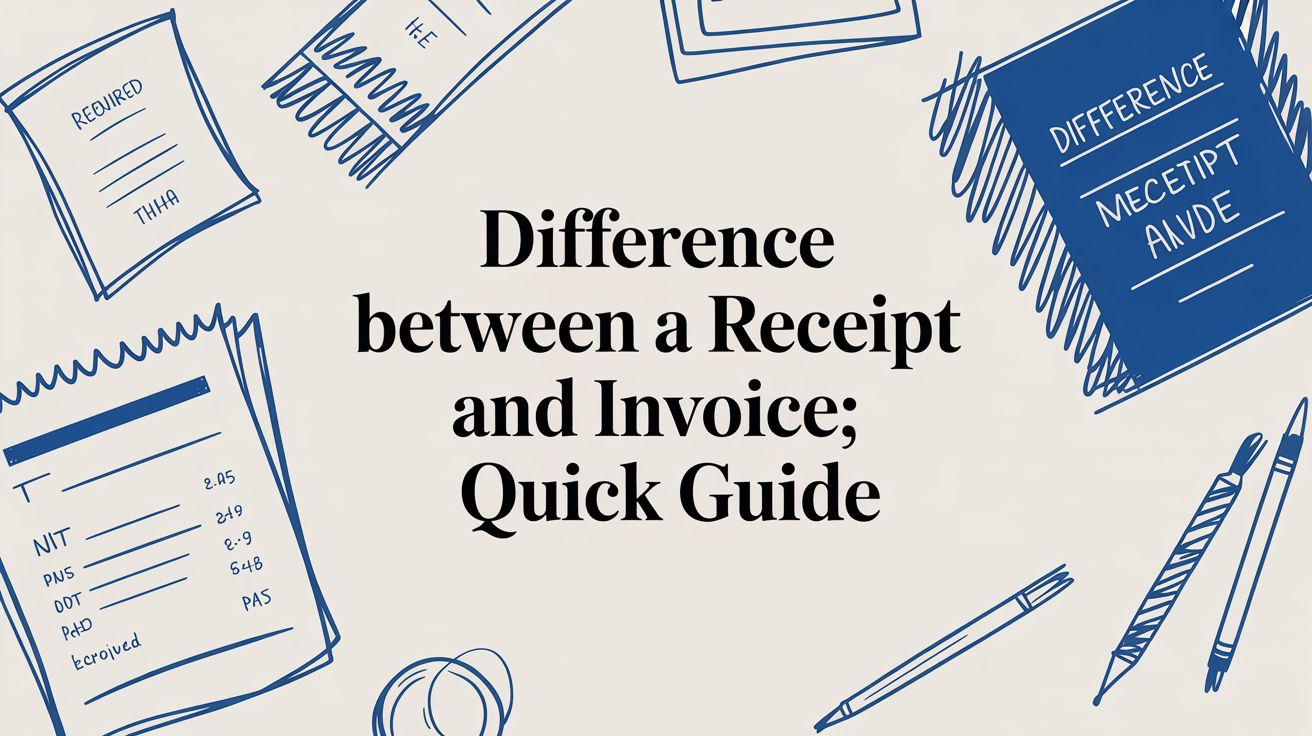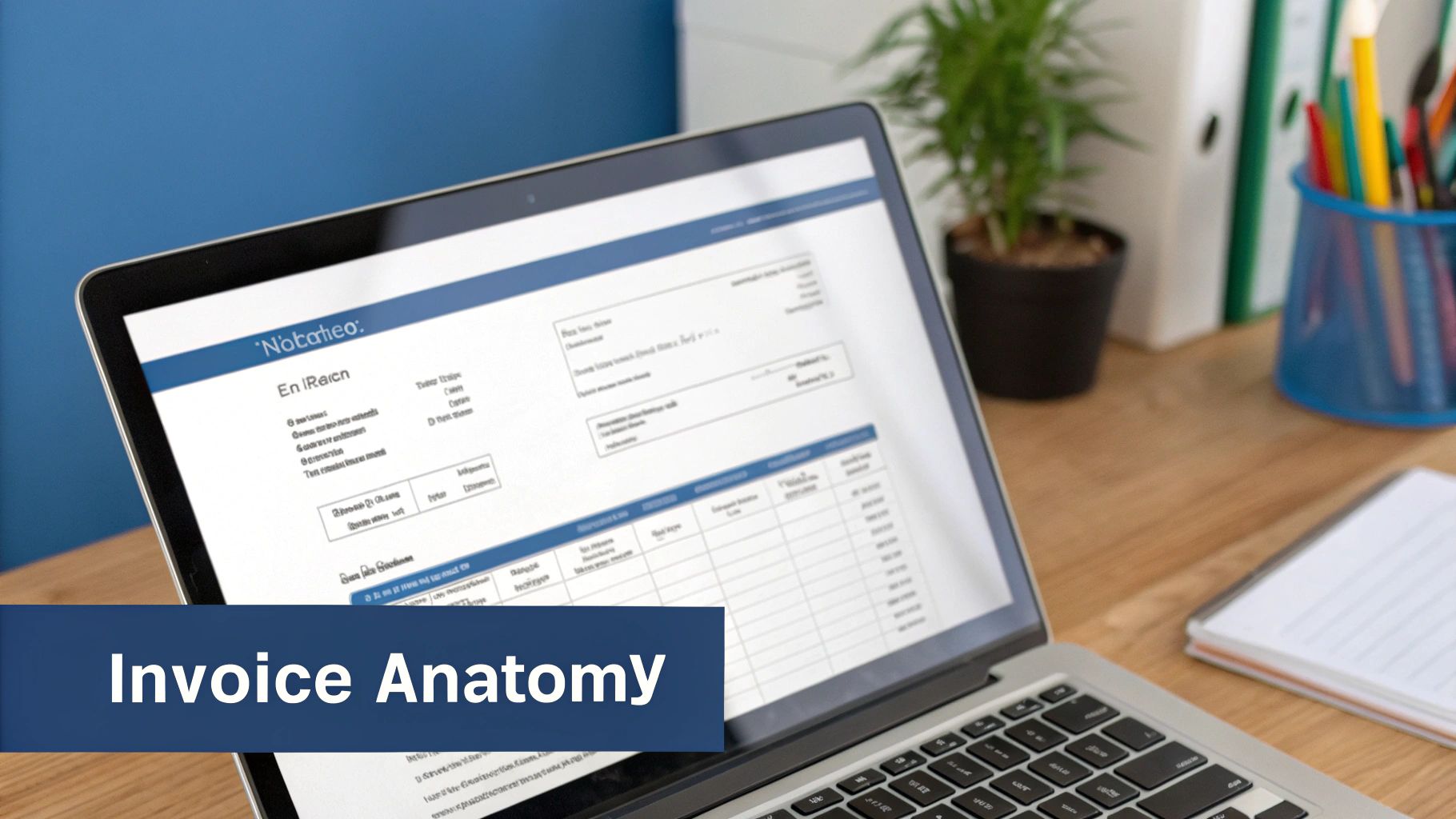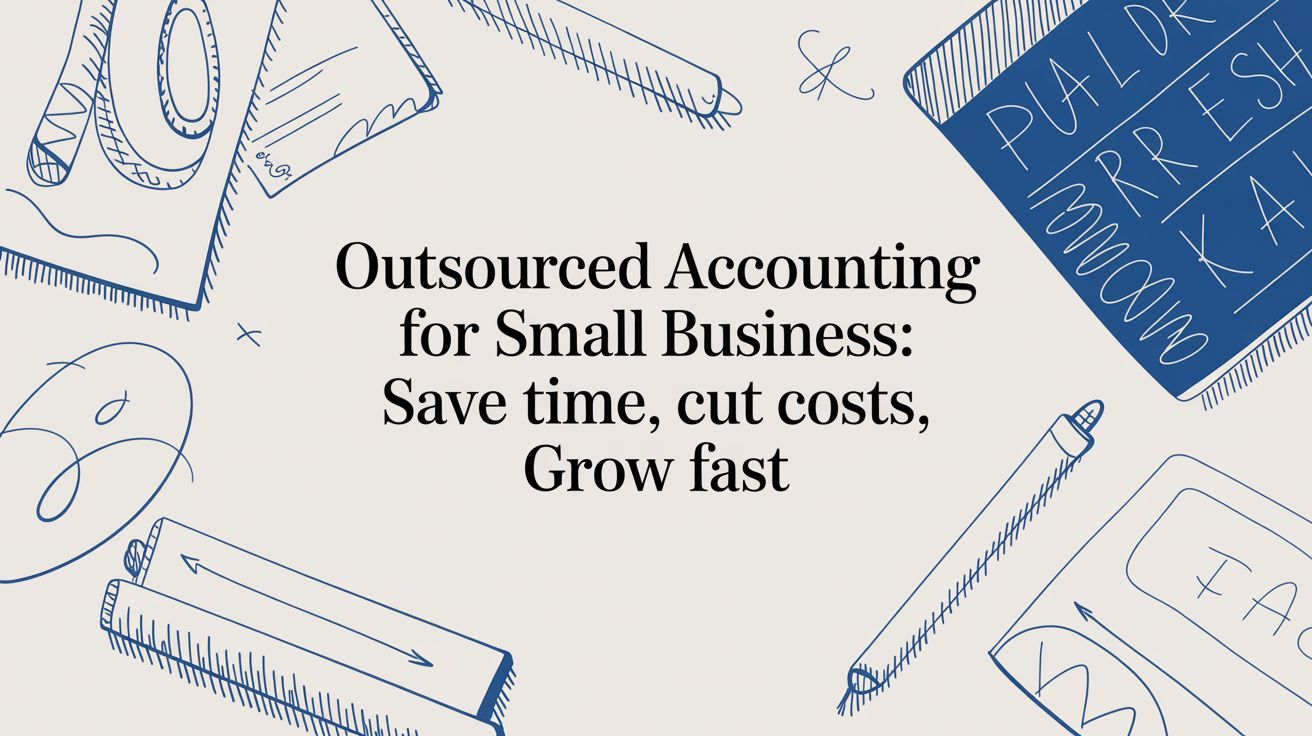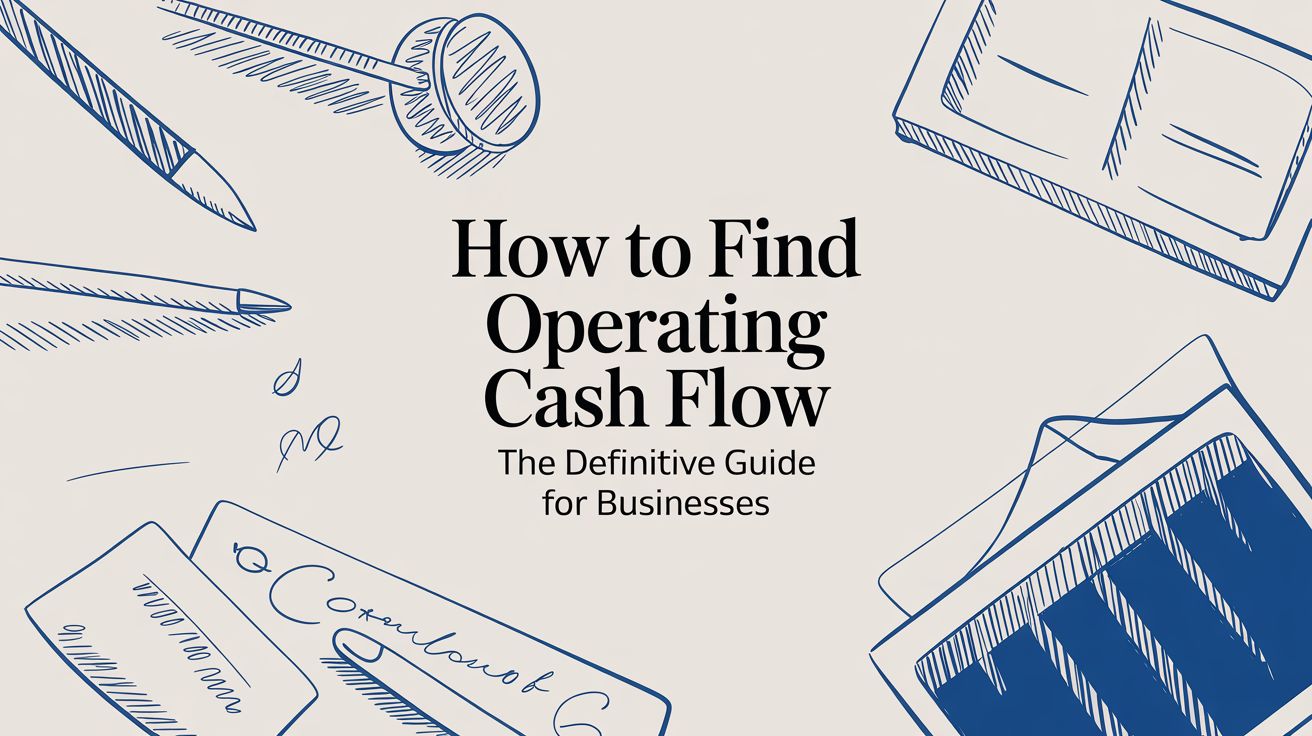
Difference Between a Receipt and Invoice: Quick Guide
At first glance, invoices and receipts might seem interchangeable. They both show up in your inbox and deal with money, but in the world of bookkeeping, they play two very different—and equally important—roles.
The easiest way to remember the difference is to think about timing. An invoice is a request for payment, while a receipt is proof of payment. Imagine you’re at a restaurant. The detailed bill the server brings to your table before you pay? That’s the invoice. The little slip of paper you get after you’ve paid is the receipt, confirming the deal is done.
Understanding the Core Financial Documents
While both documents are part of a business transaction, they serve opposite functions and appear at completely different stages of the payment cycle. Getting them mixed up is a common mistake that can lead to accounting headaches, awkward client conversations, and even delayed payments. Nailing down the purpose of each is the first real step toward solid financial management.

It all comes down to intent. An invoice is proactive; it kicks off the payment process by spelling out exactly what a client owes you. A receipt is reactive; it closes that loop by confirming you’ve received the money.
In short: an invoice says, “You owe me money,” while a receipt says, “You paid me money.” This simple distinction is the foundation for accurate bookkeeping, tax compliance, and clear client communication.
Quick Look Invoice vs Receipt
For a straightforward comparison, this table breaks down the fundamental differences between an invoice and a receipt, highlighting their purpose, timing, and role in your accounting.
| Attribute | Invoice | Receipt |
|---|---|---|
| Purpose | To request payment for goods or services rendered. | To provide proof that a payment has been made. |
| Timing | Issued before payment is made. | Issued after payment is received. |
| Function | Outlines what is owed, payment terms, and due date. | Confirms the amount paid, payment method, and date. |
| Accounting Impact | Creates an entry in Accounts Receivable for the seller. | Clears Accounts Receivable and records cash/revenue. |
Understanding these key distinctions helps ensure your financial records are clean and your cash flow is managed effectively from start to finish.
The Anatomy of an Invoice: A Request for Payment
An invoice is much more than just a bill. It’s a formal, itemized document you send to a client before their payment is due, acting as an official request for the money you’ve earned. Unlike a simple note asking for payment, a professional invoice kicks off your accounts receivable process and spells out exactly what you did and what it costs, leaving no room for confusion.

This practice of formally requesting payment isn’t new. In fact, some of the earliest known invoices were found on clay tablets in Mesopotamia, dating back to around 3000 BCE. They were just as essential for ancient trade as they are for your business today.
Core Components of a Professional Invoice
To be effective and legally sound, every invoice needs a few specific, non-negotiable details. Getting these right provides clarity for your client and creates a solid paper trail for your own bookkeeping.
Every invoice should include:
- A Unique Invoice Number to help you track payments and prevent duplicates.
- The Issue Date and Due Date so everyone knows when it was sent and when payment is expected.
- Seller and Client Information, including full names, addresses, and contact details for both parties.
- An Itemized List of Services or Products that breaks down exactly what the client is paying for, along with quantities and rates.
- The Total Amount Due, clearly showing any subtotals, taxes, and the final balance.
An invoice is the primary document used in accrual accounting to recognize revenue when it’s earned, not just when cash is received. It creates the accounts receivable entry that is fundamental to managing your business’s financial health.
This document is truly foundational to proper accounting. When you track your invoices, you get a clear picture of your expected income, which is absolutely critical for managing your cash flow and forecasting your finances accurately.
Structuring these documents correctly is a key part of good financial record-keeping. To see how these transactions fit into the bigger picture, check out our guide on double-entry bookkeeping explained. An invoice doesn’t just ask for payment; it serves as a legally enforceable agreement on the amount owed, making its accuracy vital for protecting your business and keeping your client relationships professional.
Deconstructing the Receipt: Your Proof of a Completed Transaction
Once a client pays their invoice, the job isn’t quite done. The receipt is the final piece of the puzzle, the official handshake that closes the financial loop and confirms money has changed hands. If an invoice is a request for payment, a receipt is the acknowledgment—it’s the definitive proof that a transaction is complete.
This document is fundamentally different from an invoice because its whole purpose is retrospective. It looks back at a payment that has already happened, giving both you and your client a clear summary. Because of this, a receipt’s key details all center on the payment itself.
Essential Components of a Receipt
Unlike an invoice, which breaks down what a client owes, a receipt confirms what was actually paid. It’s a subtle but critical distinction.
A proper receipt must include a few key things:
- Date of Payment: This is the exact date you received the funds, not the date the service was performed.
- Amount Paid: The total sum the customer handed over, including any taxes or other fees.
- Method of Payment: A quick note on how they paid (e.g., credit card, bank transfer, cash).
- Remaining Balance: If the invoice is paid in full, this should clearly state $0.00 to confirm the account is settled.
For your own bookkeeping, issuing a receipt is a non-negotiable step. It’s what allows you to move that money from “accounts receivable” into “recognized revenue” in your books. This simple action gives you an accurate, real-time snapshot of your cash flow. Without it, your records might still show outstanding payments that have actually been settled.
A receipt is an indispensable record for everyone involved. For your customer, it’s their proof for returns, warranty claims, or expense reports. For your business, it’s the final, concrete evidence of income received—absolutely essential for accurate bookkeeping and tax reporting.
Ultimately, the receipt solidifies the transaction. It wipes out any doubt about the payment status and provides the necessary paper trail for consumer protection and your own internal accounting, making sure everyone is on the same page.
When to Use an Invoice vs a Receipt
Knowing the technical difference between an invoice and a receipt is a great start, but the real test is applying that knowledge on the fly. Getting it right is what keeps your business operations running smoothly. The decision really boils down to one simple question: Are you requesting payment or confirming it?
Getting this right prevents awkward client conversations, delayed payments, and unnecessary confusion. It’s a small detail that makes a big professional impact.
The fundamental distinction is all about timing. If you expect payment after you’ve delivered goods or services, you need to send an invoice. This is the standard for most B2B work, freelance projects, or any job that’s billed in phases. The invoice is the official document that kicks off the payment process.
On the other hand, if a customer pays you on the spot, a receipt is what you’ll provide. Think about buying a coffee or checking out from an online store. Payment happens immediately, so sending an invoice would be redundant and confusing. The receipt simply confirms the deal is done.
Choosing the Right Document for the Situation
Using the wrong document can create friction and make your bookkeeping a mess. Let’s look at a few real-world situations to make the distinction crystal clear.
- When to send an invoice: A consultant wraps up a month of services for a corporate client and bills them. A graphic designer finishes a logo project and sends a bill with 30-day payment terms. In these cases, the work is completed before you ask for the money.
- When to issue a receipt: A customer buys a t-shirt from your e-commerce store and pays instantly with their credit card. A client pays for a one-off coaching session right after it ends. Here, the payment and the delivery of the service or product happen at the same time.
This decision-making process is pretty straightforward. If the transaction is paid for and complete, you issue a receipt to close the loop.

As the chart shows, a receipt is the final step, issued only after a transaction has been fully settled.
Situational Use Invoice vs Receipt
To really nail this down, a side-by-side comparison is helpful. This table breaks down the core functions and legal standing of each document, helping you pick the right one every time.
| Feature | Invoice | Receipt |
|---|---|---|
| Primary Use | To request payment for services or goods provided on credit (B2B, freelance) | To confirm payment has been received for an immediate sale (retail) |
| Timing | Issued before payment is due | Issued after payment has been made |
| Accounting Role | Tracks accounts receivable and recognizes income for accrual-based accounting | Records cash income and serves as proof for expense deductions |
| Legal Standing | A formal payment request that can become a legally binding agreement | Legal proof of a completed purchase and the transfer of ownership |
Ultimately, an invoice opens a financial conversation, while a receipt officially closes it. Using them correctly is a sign of a well-organized business that respects its own books and its clients’ accounting processes.
Why This Difference Matters for Your Taxes and Accounting
It’s easy to think of invoices and receipts as just two pieces of paper, but mixing them up is more than a simple filing error. It can have a real impact on your financial reporting and tax compliance. To your accountant, your software, and especially the IRS, these two documents tell completely different stories. Getting them wrong gives you a distorted picture of your company’s financial health and can create some serious headaches down the road.
An invoice is really the foundation of accrual-based accounting. When you send an invoice, you recognize that revenue as earned and it gets logged in your accounts receivable. This gives you a clear forecast of your future cash flow, even before the money is actually in your bank. A receipt, on the other hand, is the star player in cash-based accounting, where you only record revenue once you’ve been paid. It’s a critical distinction to grasp, and you can get a deeper dive into the difference between cash basis and accrual basis accounting in our detailed guide.
The Role in Legal and Tax Compliance
From a legal and tax standpoint, the difference is night and day. In the U.S., the Internal Revenue Service (IRS) demands clear documentation to back up any business expenses you claim during an audit. Receipts are your undeniable proof of payment for those deductible expenses, while your invoices support the income you’re claiming to have earned.
When you don’t keep these two separate, your records become unreliable. In fact, some research shows that about 45% of small and medium-sized enterprises globally run into record-keeping problems because of this exact confusion, leading to audit delays and mistakes on tax filings.
The bottom line is that tax authorities don’t see these documents as interchangeable. An invoice demonstrates what a client owes you, while a receipt proves what you were paid. One supports your income claims, and the other validates your (or your client’s) expense deductions.
Avoiding Common Bookkeeping Pitfalls
Getting this right helps you sidestep some common—and costly—bookkeeping mistakes. For instance, if you mistakenly record an unpaid invoice as cash revenue, you’re overstating your income. That could lead to paying taxes on money you haven’t even received yet.
On the flip side, treating a receipt like an invoice might cause you to lose track of an outstanding payment, letting good money slip through the cracks. For any service business where your income is tied directly to billable hours and finished projects, this isn’t just a best practice—it’s essential for survival. Keeping a clean, clear distinction ensures your financial statements are accurate, your tax filings are solid, and your business decisions are based on reality, not guesswork.
Streamlining Your Invoicing and Receipt Management
Knowing the difference between an invoice and a receipt is one thing, but actually putting that knowledge into practice is what keeps your cash flow healthy. For any service business, creating a clear and repeatable system for handling financial documents isn’t just a good idea—it’s essential. This means using consistent templates, setting up a logical digital filing system, and automating whatever you can.
This is where modern accounting software like QuickBooks becomes so valuable. It lets you build professional, branded invoice templates that automatically pull in client details, which saves you a ton of time and cuts down on manual errors. Once you receive payment, the software can even generate and send a receipt automatically, closing the loop on the transaction.
Establishing a Clear Workflow
A simple but effective workflow is your best defense against lost documents and inaccurate accounts. A solid process should always include these steps:
- Issue Invoices Promptly: Don’t wait. Send invoices the moment a project milestone is complete or services have been delivered. This gets the payment cycle moving right away.
- Track Payments Diligently: Use your accounting software to keep a close eye on outstanding invoices. Most platforms let you set up automatic reminders for upcoming and overdue payments, which is a huge help.
- Store Documents Securely: Go digital-first. Create specific folders for “Invoices Sent” and “Receipts Issued,” organizing them by client and date. This simple habit will keep you ready for tax time or any potential audit.
Getting organized like this is a core part of building strong financial health. For a deeper dive into these foundational practices, check out our guide on bookkeeping basics for small business.
A common—and critical—mistake is to just re-send a copy of the unpaid invoice as a payment reminder. You should always use a formal reminder notice or a statement of account to avoid confusion and keep things professional.
By putting these straightforward steps into place, you can build a reliable system that not only strengthens your client relationships but also ensures timely payments and gives you an accurate financial picture of your business at all times.
Common Questions About Invoices and Receipts
Even when you feel you’ve got a handle on the difference between a receipt and invoice, certain situations can still make you second-guess yourself. Let’s walk through a few of the most common questions we see from business owners managing these key documents.
Can An Invoice Serve As a Receipt?
This is a tricky one, but the short answer is no, not really. While you might occasionally see an invoice stamped “PAID,” it’s not a great habit to get into. The entire purpose of an invoice is to ask for money, so using that same document as proof of payment can make your financial records confusing.
It’s always cleaner and more professional to issue a separate, dedicated receipt. This officially closes out the transaction for everyone involved.
A dedicated receipt provides unambiguous proof of payment that is easier for both you and your client to file and reference. It eliminates any doubt about whether an account has been settled, which is crucial for accurate bookkeeping.
Do I Need to Keep Both Documents?
Absolutely. As a business owner, you need both documents to tell the complete story of a transaction.
- As the seller: Keep copies of your invoices to track accounts receivable (the money you’re owed). Then, keep copies of receipts to confirm your earned revenue.
- As the buyer: Keep the invoices you receive to understand what you owe and when. Hold onto the receipts as proof of purchase, which you’ll need for expense claims, tax deductions, or even warranty issues.
What if An Invoice Is Incorrect?
If you send out an invoice and then spot a mistake, resist the urge to just edit the original and resend it. The proper way to handle this is to void the incorrect invoice entirely.
Then, you’ll issue a brand-new one with a different invoice number. This process creates a clean, transparent audit trail and helps you avoid payment disputes or accounting headaches down the road.
At Steingard Financial, we help service businesses build clear, efficient financial systems. We manage your bookkeeping, payroll, and AP/AR to ensure every transaction is accurately recorded, giving you the clarity needed for confident decision-making. Learn more about how we create scalable back offices at https://www.steingardfinancial.com.






